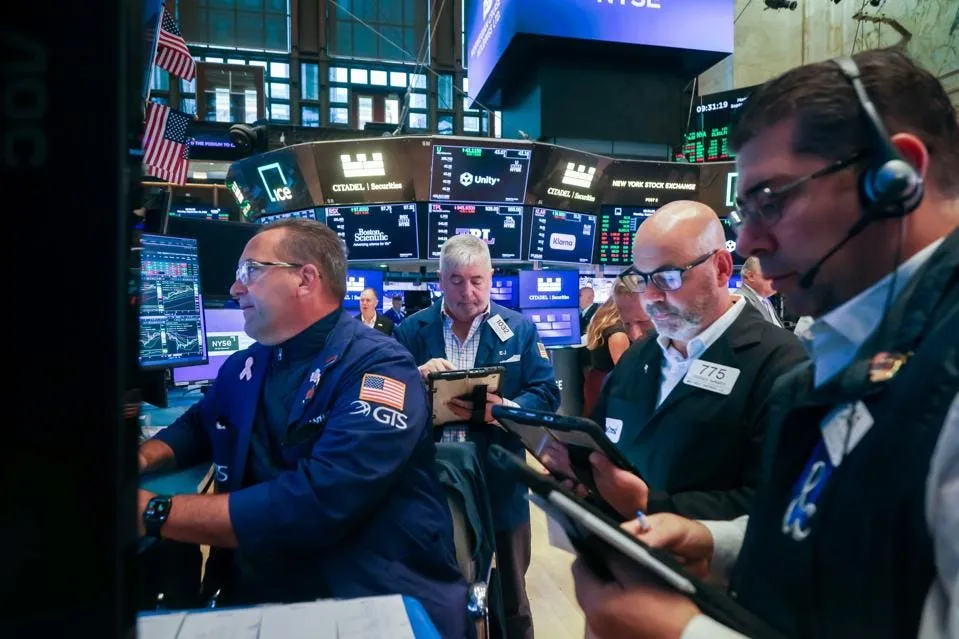AI Surge and Market Swings Mark Stocks’ Path Since Trump’s Comeback
Donald Trump’s re-election was expected to supercharge the stock market and while that prediction came true, it unfolded in ways few had foreseen. Since Trump’s victory on Nov. 5, the S&P 500 Index has climbed an impressive 18%, ending October at a record high and extending its six-month winning streak. Initially, the market’s rally was driven by hopes that Trump’s agenda centered on sweeping tax cuts and deregulation would ignite an economic boom.
Although he largely delivered on those promises, it’s his unpredictable trade policies that have truly defined the market’s trajectory. His stop-and-go approach to tariffs and negotiations pushed policy uncertainty to levels not seen since 1900, sending waves of volatility through equities most dramatically in April, when he announced the toughest tariffs in nearly a century.
“This was one of the most dramatic explosions of market volatility we’ve really ever seen,” said Dean Curnutt, CEO of Macro Risk Advisors LLC.
If not for another surge of enthusiasm around artificial intelligence, the stock market’s gains might have been far more restrained. The rally has been heavily concentrated in Big Tech, while traditional sectors such as manufacturing and consumer goods have lagged amid trade tensions and slower growth.
An equal-weight version of the S&P 500 is up just 5.2% for the year, highlighting the dominance of mega-cap tech stocks. The median stock in the index has gained only about 1.2%.
Aside from a brief hiccup in January tied to China’s DeepSeek app, AI excitement has propelled Nvidia Corp. to become the first $5 trillion company, while Apple Inc. and Alphabet Inc. each surpassed $4 trillion in market value. Collectively, the seven largest tech firms have accounted for more than half of the market’s overall advance.
“I feel like we’ve all jumped on the AI trade,” said Alonso Munoz, chief investment officer at Hamilton Capital Partners LLC. He described investors’ conviction that AI is still in its early growth phase with breakthroughs continuing to outpace expectations. Munoz shifted his portfolio in April, trimming defensive holdings to increase exposure to AI leaders such as Alphabet.
Even as AI stocks soared, market turbulence tied to Trump’s policies persisted. Tariff threats routinely triggered sharp moves in various sectors. Trump also moved markets through direct intervention, pushing Intel Corp. shares higher after the company agreed to give the U.S. government a 10% stake in exchange for grant funding. Similarly, the administration required an equity stake in U.S. Steel for deal approval and took ownership positions in small mining companies deemed critical to national security, boosting the sector.
Trump’s outspoken criticism of the Federal Reserve including attempts to oust one of its officials also contributed to financial market jitters. Curnutt warned that such constant volatility could wear on investor confidence over time. “My concern is markets are not anti-fragile,” he said. “There’s only so much uncertainty they can absorb before it starts to matter.”
Still, an 18% gain since the election is nothing to scoff at. Yet, compared with the prior year’s 36% jump, it appears more modest. U.S. equities now rank just 54th globally, trailing markets in Canada, Japan, and Germany.
Looking historically, Trump’s current post-election performance ranks eighth out of all first years following presidential elections in the past 80 years behind Joe Biden, Bill Clinton, Barack Obama, and Franklin Roosevelt’s final term, according to CFRA data.
Consumer-facing stocks have been among the hardest hit. Shares of Chipotle Mexican Grill Inc. plunged last week after the company warned of softer customer demand. The consumer staples sector has also weakened as tariffs pressure profit margins. Materials stocks down roughly 8% have faced similar headwinds, contending with higher input costs from global suppliers, particularly in China.
Even so, Curnutt noted that the allure of AI has made it “impossible not to be in the U.S. stock market.” He pointed to the market’s depth, liquidity, and broad participation as reasons investors continue to stay engaged despite recurring risks.
There are emerging signs that Trump’s trade-related volatility is beginning to ease. His recent trip to Asia yielded concessions from several nations, and concerns about Chinese competition in AI have diminished since February. Meanwhile, corporate earnings have remained strong, supporting elevated valuations.
“I, for one, feel more confident sitting here today than last year,” said Michael Dickson, head of research and product development at Horizon Investment LLC. A year ago, he said, investors were uncertain about the scale of AI infrastructure spending and which segments of the supply chain would benefit most. “Now, we have a clearer picture and the upside potential is keeping traders invested despite the noise,” Dickson added.
He believes AI-driven productivity gains will continue to lift the market. “We didn’t fully grasp the extent of this transformation last year,” he said.
Still, even the AI boom carries its own risks. Some analysts warn of a possible bubble forming, while the effects of tariffs could eventually spill over to consumers. Rising costs are beginning to strain lower-income borrowers, and a potential uptick in inflation could complicate the Federal Reserve’s plans to cut interest rates as aggressively as markets anticipate.
“Policy changes take time to ripple through the U.S. economy,” said David Phipps of Picton Mahoney. He added that investors now face a balancing act the risk of a market correction due to stretched valuations, and the fear of missing another powerful AI-driven rally. “There’s also a chance,” he said, “that the broader U.S. economy could accelerate faster than expected.”

Subscribe to our newsletter!
As a leading independent research provider, TradeAlgo keeps you connected from anywhere.








